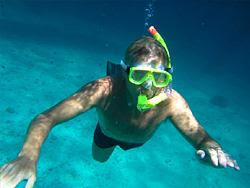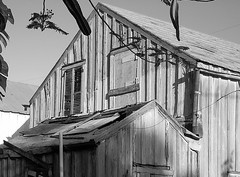 Early one morning I got a frantic telephone call from my friend Jim. "Get your mask and snorkel and get down here a soon as you can! It’s an emergency!" Jim was an active fellow, but was blind as a bat without his coke-bottle-thick glasses. Earlier that same morning he had capsized his Hobie Cat on the bay side of the Keys (it was his dog’s fault, he explained), just off of the Buccaneer Lodge in Marathon (FL), and lost his brand new state-of-the-art bifocals in the process. To make matters worse, his charter sailing business was slow that summer, so his hardworking (and long-suffering) wife Fran had laid out a couple of week’s paychecks for Jim’s new specs.
Early one morning I got a frantic telephone call from my friend Jim. "Get your mask and snorkel and get down here a soon as you can! It’s an emergency!" Jim was an active fellow, but was blind as a bat without his coke-bottle-thick glasses. Earlier that same morning he had capsized his Hobie Cat on the bay side of the Keys (it was his dog’s fault, he explained), just off of the Buccaneer Lodge in Marathon (FL), and lost his brand new state-of-the-art bifocals in the process. To make matters worse, his charter sailing business was slow that summer, so his hardworking (and long-suffering) wife Fran had laid out a couple of week’s paychecks for Jim’s new specs."You don’t understand," he explained when I got there. "If we don’t find those glasses, it could really affect my vision."
"Yeah, I guess so," I replied. That figured. No glasses, no vision.
"No, you don’t get it. If Fran finds out, she’ll scratch my eyes out!"
We sailed back to the Buccaneer, as Jim explained that he was sure he knew where he was when the boat tipped. There was a sandy patch, about 100 feet offshore. He had taken bearings off the old Clark house, and the Buccaneer docks.
I had learned from diver friends that the best way to locate something underwater was to set up a grid pattern and to search systematically. That way you could cover all of a certain area, not backtracking needlessly or missing anything. We snorkeled back and forth for over an hour.
There were sand patches, turtle grass, fish, sponges, even an occasional conch shell, but no glasses. We conferred about the location briefly, and started on another grid pattern. By now Jim was much farther offshore, and was starting to shout, "Come on, they gotta be out here somewhere!"
I decided to keep looking where I was for a little longer before moving out. Then I spotted a pile of underwater debris and swam down for a closer look. There, on the bottom, were two bent welding rods! (I swear this is a true story.) I brought them to the surface, remembering that they could be used as divining rods to find things. I grabbed them by the short ends and swam in a circle with the idea that they would indicate the direction to go to find the glasses.
(I should also explain that by this time I had already come under the influence of the Baptists, and as you may know, one of the things we don’t approve of is dabbling with low-level psychic phenomena, so I continued the process only with serious misgivings).
Jim was still shouting in the background for me to swim out and join him offshore. "Out here! Out here!" Just then the two rods crossed in front of me.
"OK, OK!" I shouted. I decided to swim forward with the rods for a minute, before joining him in the deeper water, basically thinking I was wasting my time and indulging in a silly superstition that I had long ago discounted. The rods crossed again. I looked down, and there, right on the bottom in front of me, were the glasses. I dropped the rods, and swam down and scooped them up.
"Come on, come on, you’re wasting your time. They’re out here!" Jim was bellowing, as I surfaced. He told me later he just couldn’t believe it, when I came up with them, and told him, "I got ‘em!"
For years afterward, whenever the story of the lost glasses came up, Jim still looked at me as if he suspected that I found them early on, and made up the story about the rods just for fun. Either way, he was darned happy to get them back.

 Another device used by old-timers was the pendulum. A simple plumb bob will suffice for this purpose. Chester Clift, who was a well-known dowser from Washington County in New York State, favored this method. (Chester used to spend the long upstate winter fashioning pendulums out of unusual rocks and stones for his many friends and followers.) The motion of the pendulum, held on a short string by the dowser, naturally follows either a clockwise, counterclockwise, or a back and forth motion. With this method, the individual dowser decides which of these motions indicates the presence of water or other objects and interprets the results accordingly. And of course, as you'll see if you try it, you can control the motion of the pendulum with the slightest movement of your hand.
Another device used by old-timers was the pendulum. A simple plumb bob will suffice for this purpose. Chester Clift, who was a well-known dowser from Washington County in New York State, favored this method. (Chester used to spend the long upstate winter fashioning pendulums out of unusual rocks and stones for his many friends and followers.) The motion of the pendulum, held on a short string by the dowser, naturally follows either a clockwise, counterclockwise, or a back and forth motion. With this method, the individual dowser decides which of these motions indicates the presence of water or other objects and interprets the results accordingly. And of course, as you'll see if you try it, you can control the motion of the pendulum with the slightest movement of your hand.
 Imagine the plight of an intelligent, relatively educated young person in that country. He or she can only secure a decent future by attaching himself to a powerful patron in a position of relative servitude, by allying himself with a criminal enterprise which preys on the weak, or by finding a way to get out. They live in a country whose population has so far outstripped its resources that it is literally devouring itself. And all this is happening within a one-day cruise ship ride from Miami.
Imagine the plight of an intelligent, relatively educated young person in that country. He or she can only secure a decent future by attaching himself to a powerful patron in a position of relative servitude, by allying himself with a criminal enterprise which preys on the weak, or by finding a way to get out. They live in a country whose population has so far outstripped its resources that it is literally devouring itself. And all this is happening within a one-day cruise ship ride from Miami.

 And as far as Elian goes, not to worry--as any student of human "body language" can tell you: he’s not into it. And you don't have to be a psychologist to know, even at his tender age, he'd be a lot more comfortable sipping a mojito out on Sobe than reciting dated Marxist propaganda to a bunch of superannuated politicos.
And as far as Elian goes, not to worry--as any student of human "body language" can tell you: he’s not into it. And you don't have to be a psychologist to know, even at his tender age, he'd be a lot more comfortable sipping a mojito out on Sobe than reciting dated Marxist propaganda to a bunch of superannuated politicos.






